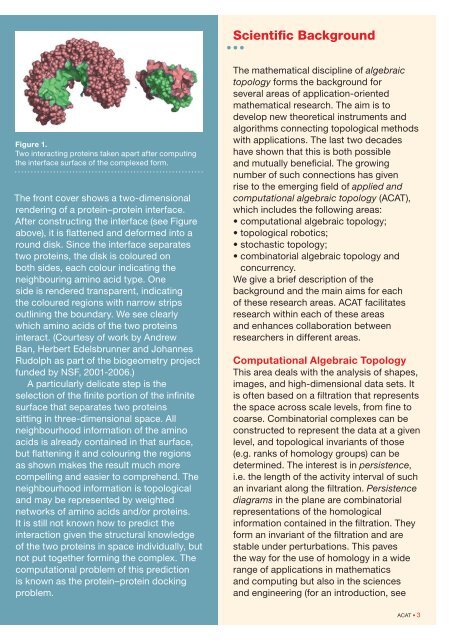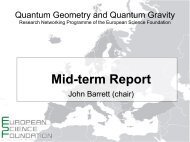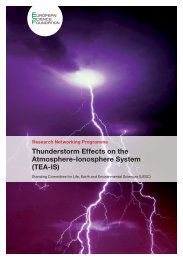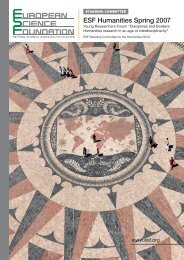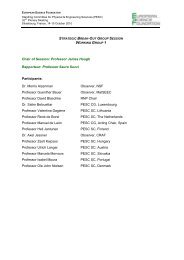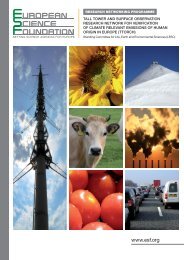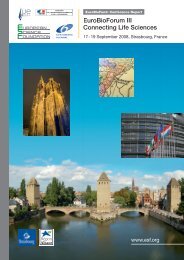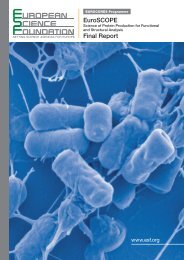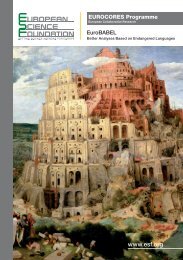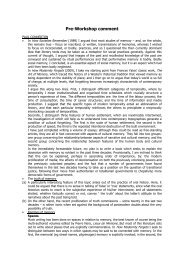Applied and Computational Algebraic Topology (ACAT) - European ...
Applied and Computational Algebraic Topology (ACAT) - European ...
Applied and Computational Algebraic Topology (ACAT) - European ...
Create successful ePaper yourself
Turn your PDF publications into a flip-book with our unique Google optimized e-Paper software.
Scientific BackgroundFigure 1.Two interacting proteins taken apart after computingthe interface surface of the complexed form.The front cover shows a two-dimensionalrendering of a protein–protein interface.After constructing the interface (see Figureabove), it is flattened <strong>and</strong> deformed into around disk. Since the interface separatestwo proteins, the disk is coloured onboth sides, each colour indicating theneighbouring amino acid type. Oneside is rendered transparent, indicatingthe coloured regions with narrow stripsoutlining the boundary. We see clearlywhich amino acids of the two proteinsinteract. (Courtesy of work by AndrewBan, Herbert Edelsbrunner <strong>and</strong> JohannesRudolph as part of the biogeometry projectfunded by NSF, 2001-2006.)A particularly delicate step is theselection of the finite portion of the infinitesurface that separates two proteinssitting in three-dimensional space. Allneighbourhood information of the aminoacids is already contained in that surface,but flattening it <strong>and</strong> colouring the regionsas shown makes the result much morecompelling <strong>and</strong> easier to comprehend. Theneighbourhood information is topological<strong>and</strong> may be represented by weightednetworks of amino acids <strong>and</strong>/or proteins.It is still not known how to predict theinteraction given the structural knowledgeof the two proteins in space individually, butnot put together forming the complex. Thecomputational problem of this predictionis known as the protein–protein dockingproblem.The mathematical discipline of algebraictopology forms the background forseveral areas of application-orientedmathematical research. The aim is todevelop new theoretical instruments <strong>and</strong>algorithms connecting topological methodswith applications. The last two decadeshave shown that this is both possible<strong>and</strong> mutually beneficial. The growingnumber of such connections has givenrise to the emerging field of applied <strong>and</strong>computational algebraic topology (<strong>ACAT</strong>),which includes the following areas:• computational algebraic topology;• topological robotics;• stochastic topology;• combinatorial algebraic topology <strong>and</strong>concurrency.We give a brief description of thebackground <strong>and</strong> the main aims for eachof these research areas. <strong>ACAT</strong> facilitatesresearch within each of these areas<strong>and</strong> enhances collaboration betweenresearchers in different areas.<strong>Computational</strong> <strong>Algebraic</strong> <strong>Topology</strong>This area deals with the analysis of shapes,images, <strong>and</strong> high-dimensional data sets. Itis often based on a filtration that representsthe space across scale levels, from fine tocoarse. Combinatorial complexes can beconstructed to represent the data at a givenlevel, <strong>and</strong> topological invariants of those(e.g. ranks of homology groups) can bedetermined. The interest is in persistence,i.e. the length of the activity interval of suchan invariant along the filtration. Persistencediagrams in the plane are combinatorialrepresentations of the homologicalinformation contained in the filtration. Theyform an invariant of the filtration <strong>and</strong> arestable under perturbations. This pavesthe way for the use of homology in a widerange of applications in mathematics<strong>and</strong> computing but also in the sciences<strong>and</strong> engineering (for an introduction, see<strong>ACAT</strong> • 3


